Abstract
It is to be noted that in the year 2010, about 4,700 deaths occurred due to underage drinking. Although underage drinking is prohibited in the US, it is a known fact that about eleven percent of the total alcohol consumption is being consumed by adolescents. According to the recent reports, there were about eighty-nine thousand emergency room calls by underage drinkers who needed treatment for their injuries sustained due to excessive drinking of alcohol in 2010. As per a study done by Hingson et al. (2002), high incidences of underage drinking are directly connected with increased risks of adverse lifetime alcohol-associated outcomes. The aim of the study is to provide an answer as to whether or not measurable progress has been made in controlling underage drinking in the United States in recent years.
Introduction
Background
In the United States, consumption of alcohol by the adolescents remains a persistent public safety and health issue that negatively affects the social welfare of the youths, their families, society and the country as a whole. The recent reports shows that although the adolescents also use tobacco and other hard drugs, liquor remains their most preferred choice. Alcohol abuse by underage people (persons under the age of 21 years) has remained a major health issue in the United States. Binge drinks remains the most abused drink at about 90% of of the alcohol consumed by this group. As opposed to adult drinkers, recent researches have found out that underage drinkers take very high volume of alcohol per given occasion (Wagenaar & Wolfson, 2008). According to this scholar, there were about 189,000 emergency room visits by underage drinkers who were seeking treatment for injuries caused by excessive consumption of alcohol during the year 2010.
According to Youth Risk Behavior Survey conducted in 2011, about 39% of high-school students indulged in alcohol consumption, 22% indulged in binge drinks, 8% involved in drunk driving offences, and 24% underage persons travelled with drunken drivers. (CDC, 2012). According to the National Survey on Drugs Use and Health study carried over in 2011, about 25% of the adolescents in the age between 12 and 20 indulged in alcohol consumption, and about 16% of them indulged in binge drinking. Another research, Monitoring the Future Survey of 2011 found that about thirty-three percent of 8th grades, and 70% of the 12th grades had indulged in alcohol consumption during the month preceeding that of the research. The research further indicated that about forty percent of 12th graders, and thirteen percent of 8th graders indulged in frequent alcohol consumption. It is projected that seventeen percent of the aggregate expenses on alcohol are generated from underage drinkers in the United States. The report further states that underage drinking fetches about $23 billion dollars annually to the alcohol manufacturers (Stiles, 2011, p, 43).
Underage drinking has contributed to various negative outcomes in many spheres in this country. There have been issues at schools like high absenteeism and poor academic performance, and social evils such as bullying and showing no interest in positive youth activities. Goldberg (2009, p.152) further observes that it has resulted into legal issues, which have led to arrests of the adolescents for such offences as driving while drunk, or causing physical injuries to members of the public while drunk. This social evil has also brought such physical issues on the adolescents as suffering from hangovers or sickness after excessive use of alcohol. Underaged drinking has also been reported to motive irresponsible and criminal behavior such as unsafe sexual activities, sexual assault, and higher incidence of homicide and suicide. Underaged drinking has also been cited as one of the leading causes of car- accidents, killing other innocent members of the public. Reports also show that it has also resulted into unexpected deaths due to alcohol poisoning. (CDC, 2012).
According to CASA (Center on Addiction and Substance Abuse), about sixty percent of college women who are suffering from genital herpes and HIV/AIDS attributed their unfurtunate health conditions to their alcohol addiction. About 90% of rape cases reported from college campuses in the United States were perpetrated by assailant who were under influence of alcohol (Cook & Moore, 2010). This report also shows that between 1977 and 1993, the number of adolescent women who got addicted to alcohol tripled. The report says that about 95% of the violence and crime reported from college campus is alcohol-associated.
A study carried out by Grant et al (2004) found that alcohol reliance is predominant among the 18 to 20 year-olds in this country. According to the study done byHingson et al. (2002), high incidence of underage drinking are associated with high risk for adverse lifetime alcohol-associated outcomes. There has been a concerted effort by various stakeholders to find a viable solution to underage drinking at the earliest stage. This move aims to develop a continuously approach that lasts from childhood to adolescent.
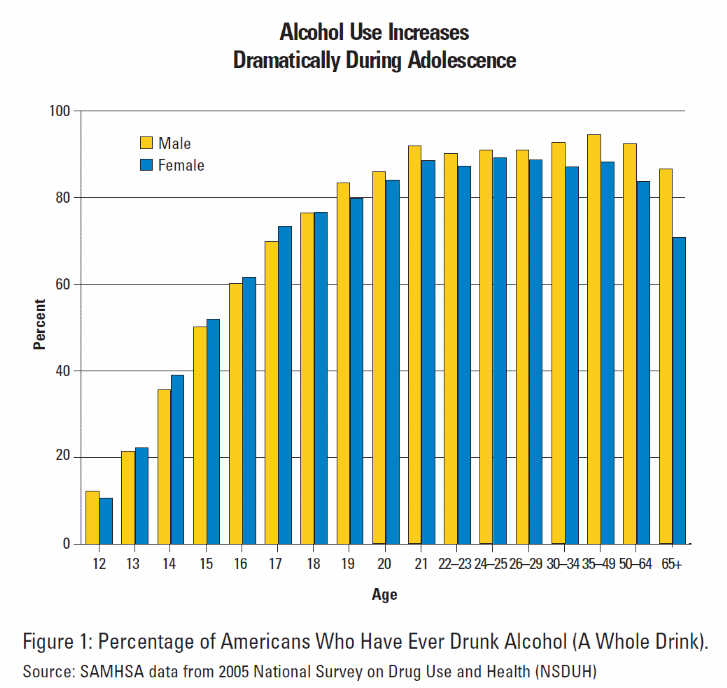
From the above graph, it comes out clealy that alcohol addiction is an age-associated incident. During the adolescent stage, the percentage of people who have a drink increases astonishingly where it reaches its peak at the age of twenty-one. In the United States, about half of the adolescent population get to drink of alcohol before attaining the age of 15 years. As per the reports by National Survey on Drugs Use and Health (NSDUH) conducted in 2005, about 5.5% of adolescents who are aged 12-17 have been confirmed to be alcohol abusers. (SAMHSA, 2005).
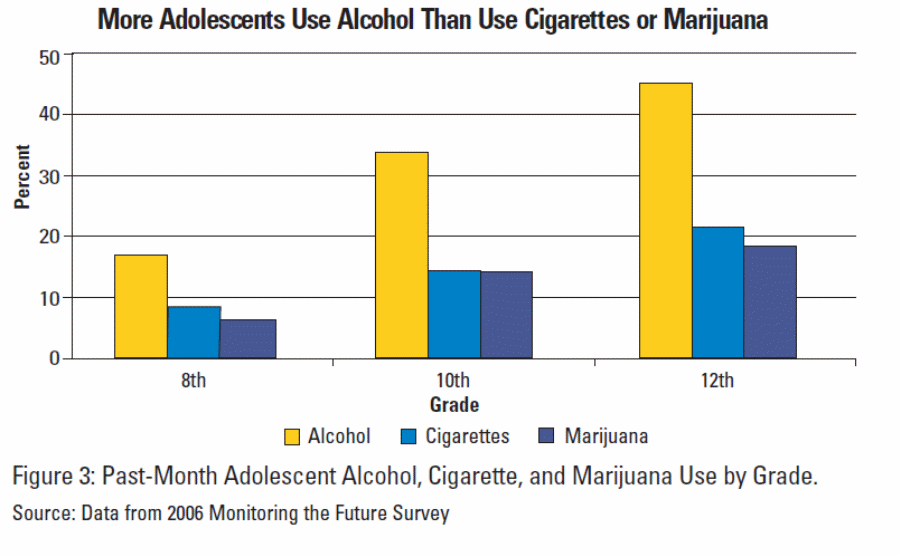
The above graph shows that students in the 8th, 10th and 12th grades preferred and consumed alcohol instead of marijuana or tobacco. According to the study by Grunbaum et al (2004), about 33% of the adolescents start consuming alcohol even before attaining the age 13 years. SAMHSA study (2006) reports that about 10% of 12 to 13 year old adolescents, and about 33% of 14 to 15 year old adolescents consumed alcohol in the past year. According Faden (2006) study, the pinnacle years of alcohol usage are in the 7th and 8th grades.
After the enactment of several national laws prohibiting underage drinking, the rate of alcohol use and dependency amongst juveniles in the United States reduced significantly (Eigen & Noble, 2006). Two of the major issues to be considered when determining the prevalence of underage use of alcohol are the rate of alcohol-related arrests of juveniles in the United States, as well as the numbers of deaths connected to underage drinking. According to the Center for Disease Control and Prevention (CDC), underage drinking in the United States is responsible for more than 4,700 deaths every year (Flower, 2012: Wagenaar & Wolfson, 2008). In addition, the Department of Justice reports that the rate of alcohol related arrests among people aged below 21 years has reduced significantly (Cook & Moore, 2010). For instance, the number of arrests reduced from 21,300 in the previous year to less than 20,000 in the year 2012. Despite this, it is not known whether the reduction in the number of arrests is an indication of the overall effectiveness of law enforcement policies and programs. In fact, there is a gap in knowledge in this area, which needs further empirical research. This study will seek to determine if significant measurable progress has been made in controlling underage drinking in the United States. The study will investigate the problem based on the number of alcohol related arrests of the target population over the past years. The target population will be persons under the age of 21 years.
Objectives of the study
This study will investigate the problem of underage drinking based on the number of alcohol related arrests made on the target population over the last five years. The target population will be adolescents aged below 21 years. The study will also seek to determine from the same arrest data if demographics have any role in underage drinking.
This study will attempt to develop empirical information concerning the problem of underage drinking in the United States. The study will investigate the problem based on the number of alcohol related arrests and synthesize available data from federal and state sources. The resulting empirical information will have policy implications for controlling underage drinking. Funding and resources for prevention and intervention programs to control underage drinking are constrained. This study will offer law enforcement agencies and community organizations data to better target those limited resources to the demographics where the problem is the most prevalent. Ultimately, the study will answer whether or not measurable progress has been made in controlling underage drinking.
Limitation of the Study
This study will use current statistical data to address and answer the research problem. In addition, the study will try to determine the effectiveness of law enforcement to control underage drinking. As such, this research study will not consider many other qualitative factors, like peer pressure or media influence, that may impact underage drinking in a similar way to the effectiveness of the laws or the legal process
Literature Review
Definition of Terms
In a research, it is always very important to ensure that people reading the material are able to understand the message brought out clearly. At times it may be necessary to use technical terms in that field. To enhance understanding of the entire paper, it is necessary that these technical terms are clearl defined.
- Underage drinking: refers to an act where a person under the age of 21 years old consumes alcohol in violation of the state laws thereby subjecting themselves to potential health and social hazards related to alcohol use and abuse
- Alcohol: it is defined a liquor, beer, spirits, wine or any other fermented beverage which has the capacity to distort the normal reasoning of the mind once it is consumed.
- Adolescents: this refers to individuas who are between the age of thirteen to twenty- one years.
- Act: it refers to law that has been enacted by the perliament meant to regulate or promote a given act among the public.
- Intoxication: this refers to the process of polluting the mind after taking excessive alcohol.
- Juvenile deliquency: this refers to criminal acts that individuals below the age of 18 years engage in, especially after getting intixicated with alcohol.
Public Possession Of Alcohol Under the Drinking Age Act
According to Cook and Moore (2010), although there is no clear laws that criminalize general possession of alcohol among the underage members of the society, stringest measures have been developed to regulate the possible its possible consumption among this group. In the United States, the Federal law defines 21 years as the minimum drinking age nationwide. Various state laws have been enacted to help curb underage drinking in this country. Each state in this country has the responsibility to enact laws that would help control alcohol consumption among the underage members of the society. In some states, underage drinking is considered as a civil offence, whereas in some states it is being considered as a crime. According to APIS (Alcohol Policy Information System), although all the states in this country bar possession of alcohol by the underage persons, only 30 states have banned its consumption, while 47 states have criminalized its purchase by underaged persons. This means that 20 states in country do not have specific laws that clearly bar consumption of alcohol by teenagers (Brickmayer, 2008, p.1).
It is a fact that consumption of alcohol by teenagers has not been legally set as valid in these states, but lack of clear laws have created loopholes for its usage among the underage Americans. Recent researches show that about 15 states in the United States currently offer family member immunity based on underage alcohol consumption laws. It is important to note that Federal law has provided exemptions for medical, religious, private club possession, and usage of alcohol by teenagers or minors. In all the states in this country, the purchase or consumption of alcohol by adolescents who are under the age of twenty-one is considered illegal. (US Legal, 2013). Alcohol intoxication is becoming common among the adolescents in various states in this country. Alcohol intoxication becomes worse when the volume of alcohol joining the bloodstream is higher than the amount the liver can eliminate through metabolism. This toxic substances would then find their way to the mind, where they get to corrupt it and make a person act irrationally. The amount consumed by an individual will dictate the level of irrationality of an individual (Sadock &Sadock, p.100).
The law is very clear when it comes to acts of ommission or commission that may be considered as a crime. When one takes excessive alcohol and engages in acts that are contrary to the set laws, then the law does specify how such an individual will be dealt with as per the crime committed. The study conducted by Miller et al (2005), notes that underage drinking costs American exchequer about $ 61.9 billion. This includes health care costs of about $ 5.4 billion, loss of productivity to the tune of $ 14.9 million, and loss of quality of life to the tune of $ 41.6 billion. According to the report by Centre for Substance Abuse Research, about 7970 adolescents are involved in alcohol consumption on any given day for the first time in this country (Cook & Moore, 2010). This report further states that about 4.3 million recent alcohol initiates were younger than 21 years at the time of initiation (Rundio, 2012, p. 22).
Minimum Drinking Age Act
In an effort to curb underage drinking in this country, the government has come up with the minimum Drinking Age Act that specifies the age under which one is allowed to consume alcohol. The following are some of the clauses in this Act.
- In case a minor uses alcohol for a recognized religious practice, then the minor must be in company of a legal guardian or parent.
- Alcohol can be used for medicinal purpose by a registered nurse, physician, dentist , pharmacist or any other recognized medical officer.
- Use of alcohol by minors in private establishments is proscribed in some states, especially when this is induced by an adult.
- Sale of liquor to underage individuals by producer, wholesaler, or retailer is prohibited (Lovenheim & Slemrod, 2010, p.75)
Impact of underage drinking: health and social problems
Alcohol usage by underage persons in the United States is considered to be more widespread as compared to usage of drugs and other intoxicants. Alcohol is being consumed by adolescents in this country at a higher rate than any other illicit drugs. Its usage by the underage individuals has been associated with death or injury of the users or people around them. Alcohol, being a drug, affects the teenager’s co-ordination, judgment, and in the long-run, their health. Alcohol consumption is associated with the car and motor bike accidents, suicides and homicides, among other social evils in this country. According to the National Household Survey on Drug Abuse study, there are about 11 million underage drinkers in the United States who are aged between 12 to 20 years. More than half of the senior high school students have stated that they consumed alcohol within the past year. Underage drinking has caused many social issues in the country such as teenage pregnancies, acquisition of sexually transmitting diseases, clashes with the law enforcement agencies, and death of the users or people around them (Abadinsky, 2008, p.17).
The report by National Center for Statistics and Analysis (NCSA) of 2009 shows that drunken teenagers were involved in automobile accidents 3 times as much as the adults.
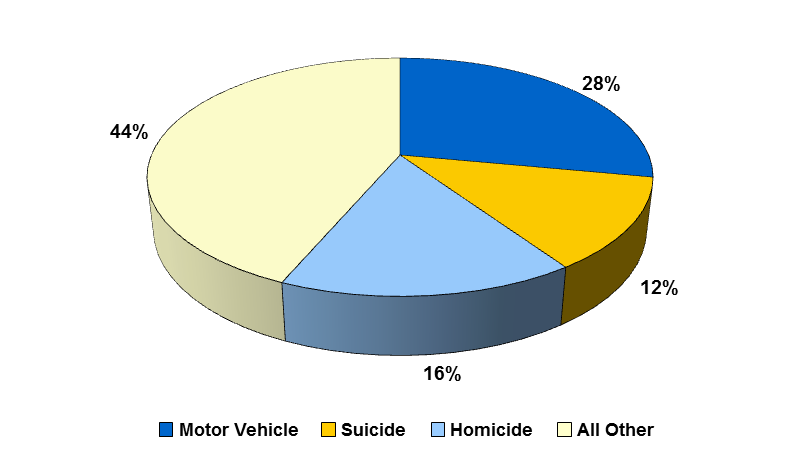
According to the study conducted by CDC (2011), about 28% of those who died in automobile accidents in the year 2008 were adolescents. Teenagers who drink and drive have higher chances of being involved in road accidents as compared to the adults. They are associated to automobile accidents due to their lesser experience and impairments caused by excessive alcohol consumption (Samhsa, 2008). The recent study carried out in the Midwest indicated that 83% of college students consumed alcohol to celebrate their birthday. Out of this, about 34% boys and 24% girls were involved in excessive consumption of alcohol. It is projected that about 1,400 teenagers became casualty per year from accidental alcohol poisoning (Rutledge, Park & Sher, 2008, p.512).
Underage drinking massively varies with ethnic and racial group. According to SAMHSA (2010) study, Black adolescents in the age of 12 to 20 years are more probable to have higher alcohol usage as compared to any other ethnic or racial groups. The White and Asian adolescents had lowest teenage drinking habits. Eaton et al (2010) note that there is a higher percentage of underage drinking before the age of 13 among Hispanic and Black youth as compared to White adolescents. It is pertinent to view the racial and ethnic variances with caution according to the study conducted by Caetano, Clark and Tam (1998). The study says that there is significant variation in alcohol usage, and other associated issues among racial and ethnic subgroups of Blacks, Whites, Asians, Hispanics, and Native Americans. The researchers further notes that the style of consumption for any subgroup or group symbolize an intricate mixture of historical, psychological, social and cultural elements (USDHHS, 2012, p.7).
Table 1
Graph 4
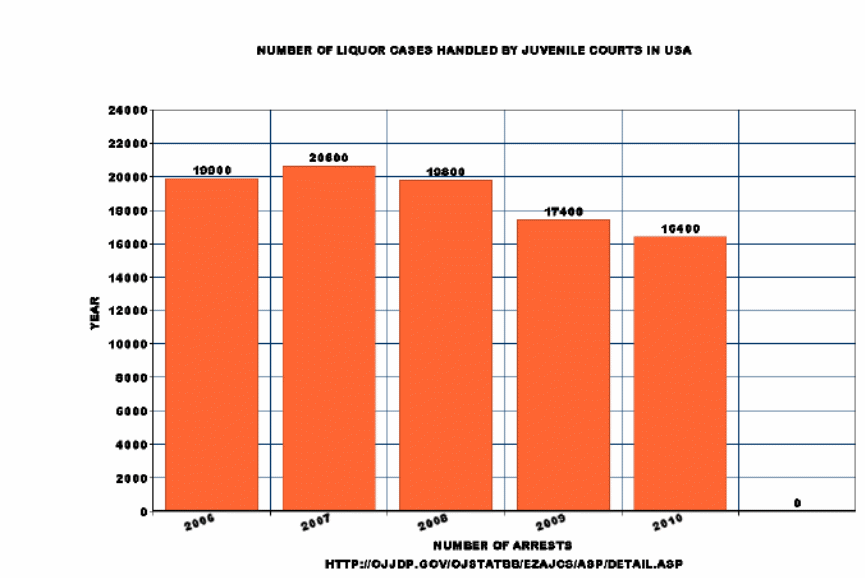
From the table 3 and graph 3 above, it comes out clearly that the number of underage drinking cases has fallen steeply from 19,900 in 2006 to 16,400 cases in 2010. Again, this statistics demonstrates that due to coercive implementation of underage drinking laws in the last five years, underage drinking has fallen substantially in the United States. The study by Surgeon General (2007) notes that underage drinking plays a major role in irresponsible sexual demeanor, including the act of having sex with multiple sex partners. In their study, Cooper and Orcutt (1977) observe that such demeanor increases cases of unintended pregnancy and sex associated diseases which affects the lifestyle of the victims According to Howe and Battaglia (1996), underage drinking poses serious medical problems to the users, including fetal alcohol symptoms, a primary reason of mental retardant. According to Winter & Wechsler (2005), underage drinking by both assailant and victim also enhances the possibility of sexual and physical attack. (USDHHS, 2012, p.11).
American Laws On Underage Drinking: Brief Review, Impact, and Problems Related to Policy Making
In the United States, strategies, regulations, and laws control and administer the usage of alcohol and other alcohol-ralated substances that may have a bearing on public health policies. The strategies and regulations that control the manufacture, distribution, sale, and usage of alcohol are governed by state, local government and federal laws. States have the privilege either to permit or bar the sale of alcoholic beverages within their boundaries and to control the sales, distribution and possession of alcohol among people of varying ages (Kleiman & Hawdon, 2011, p.13). The federal government is also controlling provision as regards to alcoholic drinks in other places where they can exercise their direct control like military bases. The federal law can also have a direct impact on state government alcoholic policies through means of incentives or financial penalties such as sanctioning or calling back the highway funds for a specific states that have failed to implement laws on alcohol usage and distribution. States have power to dilute the privileges they confer to local governments to regulate the usage of alcoholic beverages (Kleiman & Hawdon, 2011, p.13). In many states, local government agencies frame the laws that govern the sale and distribution of alcoholic beverages within their boundaries (Kleiman & Hawdon, 2011, p.13).
According to Cook and Moore (2010), state laws in the United States started operation in the 20th century with a specific aim of controling access to alcohol for the teenagers. It is to be noted that although these state laws bar the sale of alcohol to the underage members of the society, they do not directly bar alcohol drinking among this group. This is the main loophole in the present state laws on underage drinking or access of alcohol to minors. Currently, all states have prescribed 21 years as the minimum legal drinking age. However, continuous changes have been witnessed in the past. Between 1970 and 1975, minimum drinking age had been reduced to 18 from 21 years, by 29 states in this country. This was then changed to 20 years to cope irresponsible behavior that was witnessed among the young people who were engaging in excessive use of alcohol. When federal law fixing the age of 21 years as the minimum legal age of drinking was enactment in 1980s, all the states had to amended their minimum age to drinking as 21 years. The federal law demands that a percentage of federal highway funds be withdrawn from any states that do not impose a ban on underage drinking or bar the adolescents from buying or being in possession of alcoholic drinks in public. By the year 1988, almost all the states in this country had enacted their laws in tune with the federal law mainly to meet the funding requirements of federal governments with a few exemptions which vary from one state to another.
Some states have adopted preventive measures through other means such as imposing fines for using false identification to purchase alcoholic drinks, stripping driving licenses when the adolescents are arrested for drunk driving offence, zero-tolerance laws on teenage drivers and criminal fines for the adolescents who engage in unlawful activities while under influence of alcohal. (Kleiman & Hawdon, 2011, p.14).
The following measures have been introduced in the STOP 2006 Act.
- Establishing an inter-agency committee to work with federal agencies to resolve the underage drinking issues
- To make annual reports to federal agencies by the state level initiatives in the war against underage drinking.
- To start a national media crusade focused on evaluation of youth’s vulnerability to media advertisements
- To enhance the available resources for community coalition program to increase the prevention initiatives.
- To fund the new research on underage drinking (Kleiman & Hawdon, 2011, p.14).
Under United States laws, if one is a parent, then one cannot supply alcohol to the son or daughter’s teenage friends who are below the age of 21 years under whatever scenario, even with the consent of their parents. While one is consuming or is in possession of alcohol, one is not allowed to have a person under the age of 21 years within the same premises. In case of any abuse of the above regulations, one may face with six months imprisonment or a fine of $ 1250. In case a person under the age of 21 years has supplied alcohol; if such a minor has hurt themselves or others, or causes damage to any property , then any affected person can sue the individua who has supplied alcohol to a teen. Police officers are vested with the power to seize any money, alcohol, or property that is associated with teenage drinking (Criminal Defense Lawyer 2012).
Legal help available for the minors found in possession of alcohol
Minor in Possession of alcohol may receive counseling if that is a first time offence, and may be asked to engage in community service or other non-punitive punishments. The minor can also have legal assistance to represent his case by employing a local lawyer (Criminal Defense Lawyer 2012). It is important to note that the law seeks to give a stern warning to such a minor, but offer a room through which such a minor can spared from going to prison or facing other penutive measures. This does not offer them permanent immunity against the law.
Problem related to Policy Issues
When minimum drinking age was reduced to 18 years in the early 70s, there were high incidences of motor accidents caused by youths. A research study conducted by Wagennar and Toome (2005) which analysed more than 241 empirical studies conducted on the subject found that if the minimum age is reduced to 18, then there were increase in automobile accidents, and if the age is maintained at 21 age, the automobile accidents by youth reduced substantially. A case was filed in federal court against Michigan state for having increased the drinking age. It was held by the court that there existed scientific research that confirmed that lower drinking age increased automobile accidents involving drunken youths. In this case, it was clearly answered that consuming alcohol is not a fundamental privilege warranted by the American constitution. Age cannot be a “suspect” yardstick for discrimination as compared to ethnicity or race. The court further observed that the state governments have wider authority to control the manufacture and distribution of alcoholic drinks under the 21st Amendment especially to the adolescents.
In Manuel vs State of Louisiana (1996) case , the Louisiana state minimum age of 21 years for alcoholic consumption was challenged, and it was observed by the Louisiana Supreme court that prescribing the minimum age for alcohol consumption is prerogative right of a state government as it considerably lessens motor accidents caused by drunk driving. In this case, the court was of the view that as the age-21 based on empirical study, the law saved many human lives and hence, it was not an arbitrary and thus, did not infringe the Louisiana’s constitution (Wagenaar & Toomey, 2005). However, critics argue that increasing the drinking age to 21 as unconstitutional age discrimination.
Law enforcement to control underage drinking: trend, effectiveness and problems
Many past empirical studies have demonstrated that the more adolescents are vulnerable to alcohol advertisements, the more probable they are exposed to alcohol drinks. Further, it has been established that wherever there is a high concentration of alcohol advertisements, underage drinking is always on the increase. Hence, there is a close nexus between underaged drinking and alcohol advertisements. For this reason, there is a strong pressure from public health advocates to policymakers to indulge in counter-advertisement propaganda, together with initiatives to minimise adolescents’ vulnerability to alcohol advertisements. For outdoor alcohol advertisements, it is learnt that alcohol manufacturing companies are spending about $ 2 billion per annum, and the alcohol industry is spending around $ 4.5 billion per annum on advertising their products. Many states in this country have restricted the alcohol advertisements by baring the advertisements that is targeted for underaged. The law also bar publishing images of kids in alcohol ads, outdoor alcohol ads in school zones, churches and public playgrounds. However, some states have more lenient laws curbing alcohol ads than others (Kleiman & Hawdon, 2011, p.14).
In all states, it has been made illegal to drive with blood alcohol content (BAC) at or above a specified level. Many states in the US have enacted laws that allow insurers to refute insurance claims for damages caused due to drunk driving and these laws are known as Uniform Accident and Sickness Policy Provisions Laws. In case of involving drunk driving by teens, the driving license can be seized for 180 days even when no car involved in accident. For those teens who do not have driving license but engage in drunk driving, then suspension of their driving license commences once they obtain a driving license. If a teen is involved in alcohol drinking in a motor vehicle, an extra one month seizure is ordered in addition to six months seizure of their driving license. There is always a fine of $ 250, and additional fines will be levied if false ID is employed. The offender may be ordered to do community services, and they may be instructed to participate in a program of alcohol education and highway safety. (Shrewsbury Community Alliance 2012).
Host Parties and Criminal Offence
If an adolescent hosts a drinking party, he or she may face juvenile criminal charges for providing liquor to his underaged guests, and will also be held liable for host liability civil action. If a minor attends a host party and takes alcohal, he or she may be charged with juvenile criminal offence to the magnitude of his alcohol usage. The adolescents who are attending such host parties may face criminal charges applicable to their intolerable demeanor at the host party. A drunken underaged licensed driver who causes accident may face criminal charges under driving while intoxicated and vehicular homicide together with civil liability actions for the accident. Likewise, the parents of underaged drunken driver would be regarded in the same place as that of a teenager male partygoer parents and thus, accountable for their kid’s demeanor under the Family Purpose Doctrine (Rosner, 2012, p.440).
How sale of liquor to minors can be minimised
Enhancing control initiatives can minimise selling of liquors to minors by retailers substantially. Wagenaar et al (2000) study reported that there was about 35 to 40% reduction in sale of alcohol to minors when there is enhanced enforcement initiatives. States in in this country should ensure that they engage in this fight very actively by employing media promotions, and indulge by revocation of license of those disobeying the lay to enhance deterrence. State enforcement agencies should prescribe heavy fines and temporary revocation of license for the first-time offenses, and heavier fines in case of second time offenses and permanent cancellation of licenses after third time violation. The local communities and state governments should engage in media campaigns to stop consumption of liquor by teenagers. There is a necessity to enact an Act like The Synar Amendment of 1992 which requires states to legislate and implement efficient laws barring sale of alcohol to adolescents under the age of 18. States that do not adhere with the above regulation should not be allocated part of their grants which is allocated for substance abuse prevention (Bonnie, 2004, p.170).
By introducing social host laws, states can stop consumption of alcohol by adolescents substantially. Such social host laws may stipulate criminal sentences for individuals who organize social drinking parties in their homes to underage adolescents. Civil liability can also be prescribed by a victim who sustained injuries from actions of an underage drinkerd against the sponsor of such parties. As of January 2011, about 27 states in the United States have some form of social host laws. Some empirical studies have demonstrated that the existence of social host laws is linked with lesser drinking, and lesser driving-oriented causalities among young adults and youth (Miller, 2013, p.910).
Home delivery of alcohol is one area which goes unnoticed by the enforcement officials where adolescents may receive alcohol. Over 25 states in the US have allowed home delivery of alcohol and one empirical study demonstrated that about 7% of 18-20 year adolescents had been associated with alcohol drinking that had been delivered through home delivery mechanism. One other route which is to be monitored is ordering of alcohol through the internet. To put a complete halt to the supply of alcohol to the underaged, the community should either restrict or ban the home delivery of alcohol (Miller, 2013, p.910).
In some of the college events, many students consume alcohol heavily. Such events as sporting or hiking events where there is a free flow of alcohol have also contributed to increase in consumption of alcohol among teenagers. Government policies can be tailored to limit the flooding of alcohol at events and parties that are meant for underage college students. At sporting events, the usage of alcohol can be banned by colleges. One empirical study demonstrated that ban of sales of beer at football games at the University of Colorado, Boulder have minimized the rates of game day arrests, ejection from the stadium for assaults, and such other unecessary acts (Miller, 2013, p.910).
Cheap beer has been banned in almost all college campus as they provide large variety of inexpensive alcohol to students attending parties at campus. Many studies have pointed out that beer keg ban along with other policies, may lower the alcohol associated issues in the college campuses in this country (Miller, 2013, p.910). Alcohol restriction to minors through such approaches like party patrols, shoulder traps, local ban on drinking locations and keg registration have been found to minimise the rate of alcohol consumption by minors to a larger extent (Miller, 2013, p.910).
Exceptions to Minimum Legal Drinking of Age of Alcohol in USA
According to Miller (2013), in private properties like residential houses, private premises which is not open to public, consumption of alcohol by underaged adolescents are allowed in some states if the adolescents have the approval or are in the physical presence of their guardians or parents. When adolescent is accompanied by a spouse who is aged 21 years, then consumption of alcohol by teenage is not prohibited by the law when it is in a private, non-alcoholic selling premises in some states. Other states have prohibited supply of liquor to underaged without parental consent even in private properties. Each state has framed its own particular needs of what is regarded as legal.
For religious purposes, drinking of alcohol by the underaged adolescents is allowed by some states. Some states demand that alcohol should supplied by an authorised religious authority. Others have specified the quantity of alcohol that is to be served by religious institutions. Some states allow consumption of alcohol by underaged adolescents purely for medical purposes and each state has prescribed the yardstick for this. When it is associated to law or government enforcement work, the underage drinking is not prohibited by some states which cover governmental empirical research into adolescent drinking habits or working under cover (Drinking age Procon 2012).
Tort liability for providing liquors to the teenagers
Civil penalties can be imposed under tort provisions for selling or servicing liquor to teenagers. This means that tort liability provisions can be invoked against the vendors for offering liquor to an underaged person. A third party can be held accountable for selling liquor to minors under tortious liability provision. According to the study by Birckmayer et al (2008), when injury is involved due to supply of alcohol to a minor, then supplier can be charged under tortious provision which acts as an efficient mechanism for restricting underaged drinking. Social hosts such as vendors of liquor will be held accountable under tortious liability. This demonstrates that third parties can be involved as an efficient agents for minimizing underaged consumption of alcohol (Wanberg et al, 2010, p.67).
Issues in Controlling the Underage Drinking
According to Grube and Nygaard (2005), adults who supply liquor to underaged persons in social background can be held accountable for injury or damage caused by that minor. According to Whetten-Goldstein et al (2000) study, such social host laws have been found to be responsible for decline in alcohol-associated traffic accidents among adults and not among underaged adolescents. As Stout et al (2000) study notes, social host liability regulations were linked to decline in reported high consumption of alcohol and decline in drunk-driving by light drinkers, but they do not have any direct impact on drunk-driving by heavier drinkers. These mixed outcomes may mirror lack of complete programme to make sure those social hosts are conscious of their probable accountability. Some scholars have suggested that the existence of social host liability must be efficiently enforced before it can have the needed impact.
According to the report by Hibell et al (2004), governmental policies can also focus on placing restriction on particular locations or events where drinking party can be arranged like in recreational parks or in the workplace. Such restrictions will definitely impact positively in reducing adolescent drinking because they always use public place such as beaches, parks or lakes for drinking (Babor, 2010, p.144). According to Stewart (1999), new policies should be used by law enforcers to help deter sale of alcohol to the minor. For instance, the police, working in collaboration with some minors, will use the minors to approach adult strangers in the neighborhood and resquest to purchase alcohol. In case the adult yields to this request and helps the minor in any way to get alcohol, then the police would move with speed and arrest such an individual. This will pass a message to the public that the law is strict on this issue. These types of sting operations have been highly advocated for in this country as measures to minimise third-party alcohol sale to minors (Babor, 2010, p.144). According to Stewart (1999), Party Patrols acts as a local enforcement mechanism in which police will visit a social party where alcohol is served, and will confirm the age of the participants. Police should be given the mandate to enter into social gathering party to find out whether minors are involved in drinking or not (Babor, 2010, p.144).
Research Gaps
The world is fast changing, and with it are several changes in the general structure of our societies. The adolescents are expected to be the next generation of this society. It is therefore worrying that the adolescents are wasted away because of ecxcessive drining that has become common in this country. Cuijpers (2002), observe that although they have comprehensively looked at ways of dealing with underage drinking in this country, theis study has not narrowed down to a specific approaches that can be used by various institutions in this country iniversally. This view is shared by Skara & Sussman (2003), who says that the available bodies of literature have not given a comprehensive outlook on how some of the monors get introduced into alcohol against their wish. Cook and Moore (2010), admits that their scope is limited to global issues of underage driniking in the United States.
It is upon this that the researcher decided to conduct this research in order to fill the gaps that other literature had left. There was need to respond to some pertinent questions raised by these scholars when summarizing their works. Falah (2005) asks, “Is our society going to rot because of poor policies that have failed to fight underage drinking among the American adolescents?” Another scholar, Huseth (2012) poses, “In a society that is characterized by adolescents who are addicted to alcohol able to retain the American dream?” these questions need responses, and this is what this research focuses on as a way of playing a role in the fight against alcohol use among the adolescents.
Research Methodology
This chapter focuses on various aspects of research development. It includes methods of data collection, its analysis and presentation procedures. Every research project applies a certain research method to achieve its objectives depending on its goals. The methods used to conduct research in this project compared closely with the methods proposed in the project proposal. This was so because the proposal had been proven to be workable. In research, design deals primarily with aims, uses, purposes, intentions, and plans within the practical constraints of time, location, money, and availability of staff (Wang, 2008, p. 11). The chapter gives an overview of the purpose of collecting and analyzing data and the basic questions used to gather the desired responses. Defining methods of data collection is very important in research for it clearly shows ways through which data will be collected.
Research Questions
According to Cuijpers (2002), it is always important to set research questions that will help define the path that the researcher will take in collection of data. It is possible that the researcher can enconter a lot of interesting information, most of which may be irrelevant in the research. However, having research questions help in guiding the researcher as it will be a constant reminder that they need clear responses. In this research, the researcher developed the following research questions.
- What is the total number of underage drinking cases processed in the United States?
- What are the top ten states with underage drinking cases processed over the years?
- Does the data for those ten states show an increase or decrease in underage drinking over the last years?
- Amongst the top ten states is there a pattern of underage drinking related to demographics such as race, gender, or geography?
- Were there any laws or strategies implemented in the last five years which may have effected an increase or decrease in underage drinking?
This study attempts to develop empirical information concerning the problem of underage drinking. In addition, the information will have policy implications for controlling underage drinking in this country. Funding and resources for prevention and intervention programs to control underage drinking are limited and constrained. This study will offer law enforcement agencies and community organizations data to better target those limited resources to the demographics where the problem is the most prevalent.
The empirical research will conduct quantitative data analysis based on the secondary materials and sources. In addition, the study will employ qualitative data analysis to provide an in-depth analysis and description of the study problem. A detailed analysis of the existing literatures will be adopted as a study method to synthesize a hypothesis in order to draw specific conclusions from all data collected and analyzed. Data will be collected from websites and databases of organizations and agencies who maintain quantitative statistics and information regarding crime in the United States. The Department of Justice and The Office of Juvenile Justice Delinquency Prevention both have widely available data that can be used regarding underage drinking over the last five years (Gralton & Jones, 2010, p.73). This study will evaluate the data collected from those websites and other online sources, including University Online Library.
Data from the previous research will be collected for the purpose of evaluating the effectiveness of the current law enforcement process in controlling underage drinking. Specifics as to geography, race, and gender can be obtained from those national databases as well as other previous studies on underage drinking. The researcher will create a graphic representation of underage drinking in the last years and other information and tables that portray data collection results. In addition, keywords and internet links to underage drinking studies will be used to locate important and relevant materials for the execution of the qualitative aspects of the study (Maxfield & Babbie, 2011).
All data is readily accessible from websites that are regularly updated. They cover the last years of statistical data necessary to complete study on underage drinking. The Department of Justice, the Office of Juvenile Justice Delinquency Prevention, and Online Library have abundant data to comprehensively support the study on underage drinking.
Data Collection
The study will conduct quantitative secondary data analysis primarily of empirical research and data based on secondary materials and sources. In addition, the study will employ qualitative secondary analysis to provide an in-depth analysis and description of the study problem. A detailed analysis of the existing research and literature will be adopted as a study method to synthesize a hypothesis in order to draw specific conclusions from all data collected and analyzed. The quantitative data will cover the last five years of collected data for underage drinking arrests. The aggregated quantitative data will be specific to top ten states where underage drinking arrests were greatest. The demographics of those arrested will also be quantitatively collected and analyzed, including data on race, gender, age, and geography.
Data Analysis
Data analysis refers to the process of transforming raw data into refined useful information that can be of use to people (Cuijpers, 2002). It is through the analysis that the researcher would be in a position to confirm or refute the hypotheses developed in previous chapters. Huseth (2012) asserts that a research’s success would be determined by how well the analysis is conducted. As explained elaborately in the previous chapter, depending on the type and accuracy needed, data analysis can take a simple descriptive form, or a more complex statistical inference. Cuijpers (2002), explains that the researcher can also choose to take univariate, bivariate or multivariate approach to data analysis. In so doing, it is very important that the researcher ensure that the assumptions relating to the method are met. Skara & Sussman (2003) say that in analyzing data, a researcher should choose the best statistical tool that would best lead to the desired answer. The research will focus on the analysis of the research questions which had been developed earlier. The following questions were analyzed in this research.
What is the total number of underage drinking cases processed in the United States?
This was the first question in this research study. The following table shows the respinse to this question as obtained from a Report to Congress on the Prevention and Reduction of Underage Drinking.
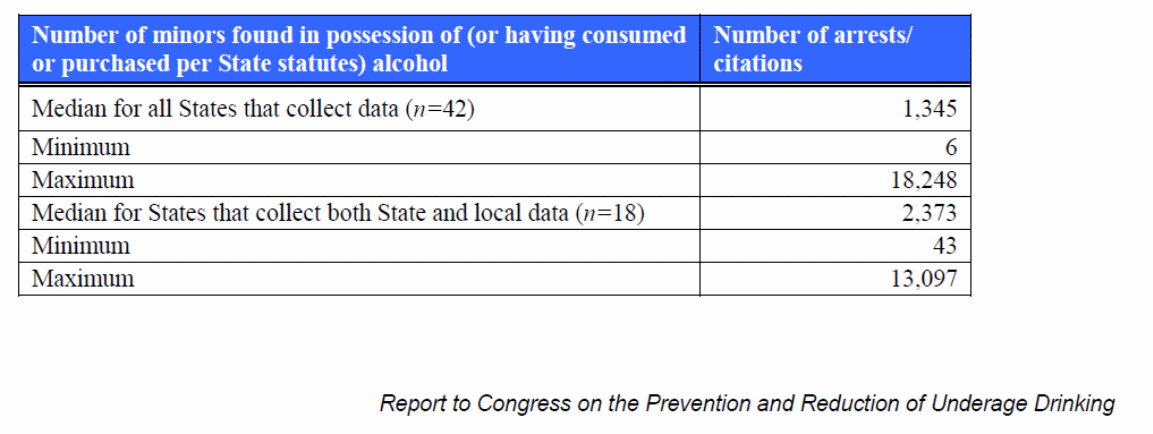
The above table provides the figures of arrest reported by all states in the USA that gather such information. These data may not offer exact figures of MIP (Minors in Possession) enforcement as the majority of the MIP arrest or detention is carried over by local police. The second and third row in the table above only offer data from those states that gather both the local and the state information. When data from such states are included, the average number of arrests increases by about three-fourth, thereby stressing the significance of local enforcement initiatives. This is further demonstrated in the graph below.
From the below graph, it comes out clearly that the number of road fatalities caused by drunk-driving caused by minors under the age of 21 years have fallen steeply in 2011 as compared to 2007 figures, and this again can be attributed to stricter enforcement of MIP laws. This means that, the underage drinking in United States is being controlled.
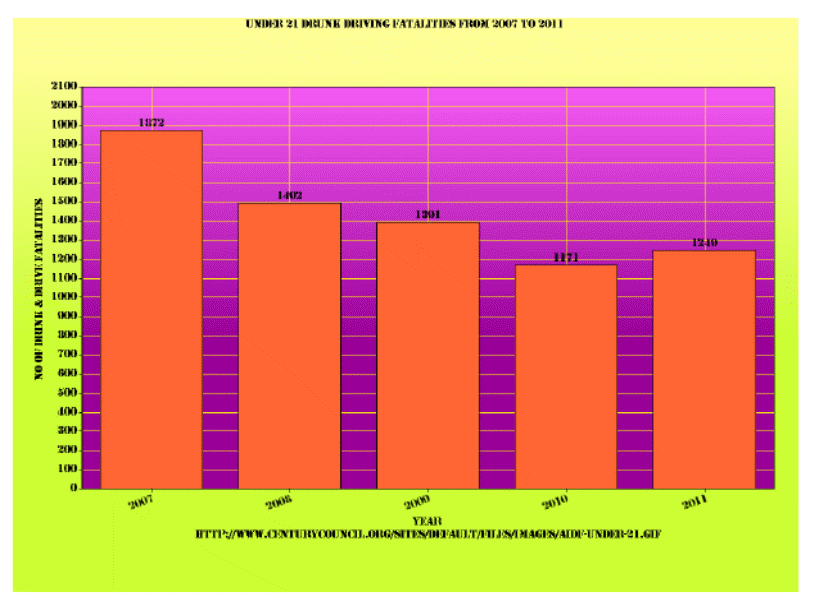
The second question in this research was focused on determining if underage drinking was on the rise in the selected state ot not.
Does the data for those ten states show an increase or decrease in underage drinking over the last years?
Table 4
According to 24/7 Wall St. research study (2012), about 23.5% of underaged people are reported to be drinking alcohol in the above 10 states as compared to 21.9% nationwide. From the above data, it is clear that Arizona tops all the state as it reported about 26.50% of binge drinking. Wyoming State is ranked top of all states in driving after drinking alcohol, and highest rate of teen’s under the age of 13 years with drinking habits. North Dakota also tops the list of drunk-driving by teens (Foxbusiness.com, 2012).

According to the data collected from Anchorage Underage Drinking Survey (2010), interviewees had a very little knowledge with legal outcomes of underage drinking. Majority of the interviewees preferred a less harsh punishment. About 43% of interviewees stated that community service was the proper punishment for underaged drinking. About 23% of the interviewees were of the view that suspending the driving license for a period of 12 months was more appropriate, while 17% recommended some other punishment as the most fitting answer to underaged drinking. Majority of the respondents were of the opinion that adolescents who were involved in driving after drinking should be punished more severely than those who only indulged in underage drinking. Majority of the respondents recommended community service as the most appropriate punishment instead of revocation of adolescent’s driving license or imposing fine.
Generally, respondent recommended a mixture of fines, community services, dissemination of knowledge and rehabilitation or treatment as a way of fighting this vice. The majority of the respondents were also of the view that vendors who sell alcohol to adolescents should face stiffer punishment. Respondents were also of opinion that there should be some punishment or fine for those adult who offer alcohol to adolescents, but opposed revocation of driving license or levying imprisonment. The respondents were also of the view that there should be some sort of punishment to those who sell or give alcohol to underaged kids. (Justice.uaa.alaska.edu, 2010).
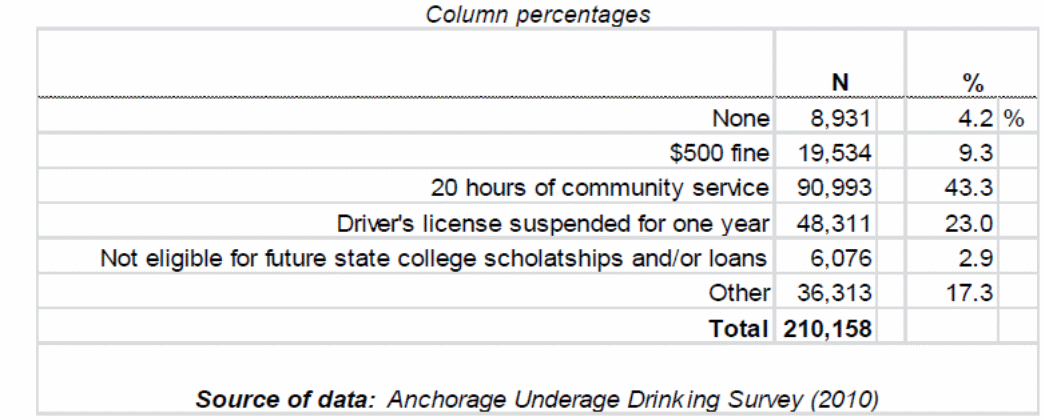
Majority of the interviewees were of the opinion that they were unaware of how effective the criminal justice policies aimed at adolescents were, but felt that the present laws were adequate and aggressively implemented. Interviewees were of the opinion that they were unaware of information about government’s underage drinking policies and its effectiveness in focusing on adolescents who contravene underage drinking regulations. They also reported that they were unaware of policies and its impact on targeting adults who supply alcohol to underaged adolescents. (Justice.uaa.alaska.edu, 2010).”
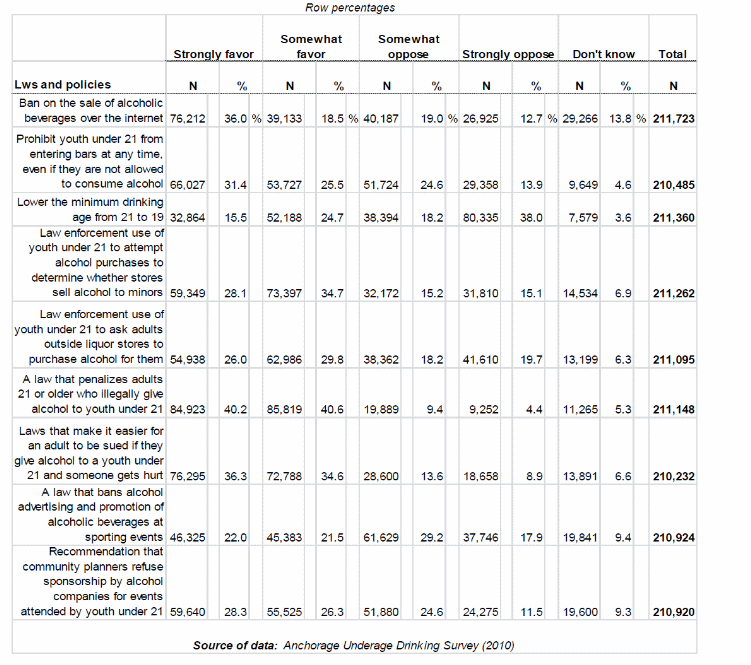
Support for Policies Designed to Reduce Underage Drinking
Many of the respondents reported that they were unaware how the government was using various agencies to fight underage drinking among the youth. However, they noted that government’s presence was being felt in the fight against underage drinking. Many of the respondents were of the opinion that the juvenile justice system are currently able to handle underage drinking cases. About 44% of the respondents replied that they were unaware of the effectiveness of this system. About 38% were not aware whether legal outcomes for underage drinking crimes are adequate for adolescents under aged below 21. About 46% of the respondents were of the opinion that there are adequate laws to combat the underage drinking, and 47% were of the opinion that officials are properly implementing the underage drinking laws. (Justice.uaa.alaska.edu, 2010).
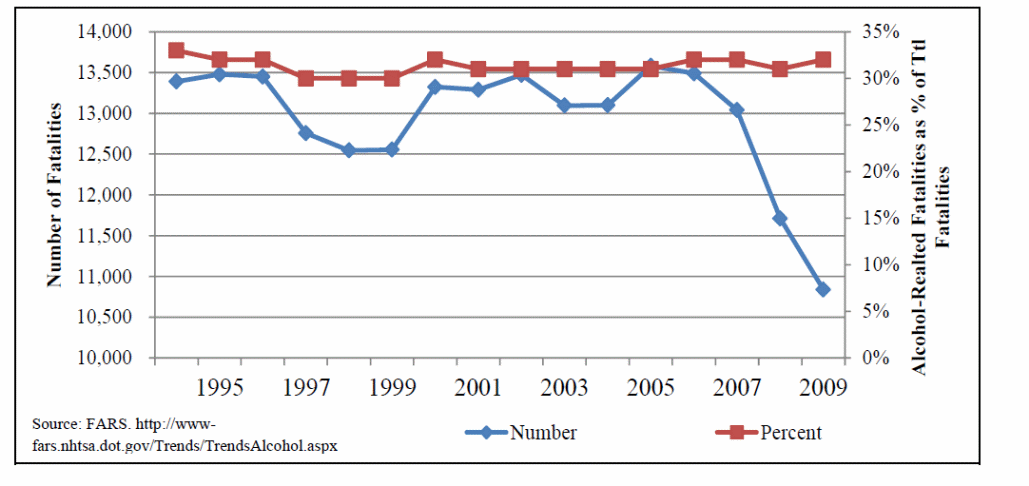
In the United States, impaired driving has become a hot issue in the recent past, and as per American Automobile Study (2010), majority of the US citizens feel that drunk driving is a danger to their personal safety. It is to be observed that impaired driving has been the spotlight of law enforcement agencies, public awareness and government policy for many years in the recent past. Due to this, there has been considerable decline in rates of alcohol-impaired driving in this country as per the above table. The rate of deaths due to impaired driving came down from 13,250 in 1995 to 10,750 in 2009 (Huseth, 2012, p.2). In the following table, it is clear that Vermont is the best state in fighting drunk-driving, where alcohol-impaired fatalities remained just 0.16% per 100 million VMT, whereas the Montana is the worst state in this fight where alcohol-impaired fatalities remained at 0.84% per 100 million VMT in the year 2008. Utah stands at second best state place in this fight, whereas South Carolina stands at second worst state in the fight against alcohol impaired fatalities. According to Yagil (1998), the overall tendency in alcohol –impaired driving can assist in identifying where improvement is required. The above state wise data is helpful in estimating the alcohol-associated automobile crashes (Huseth, 2012, p.3)
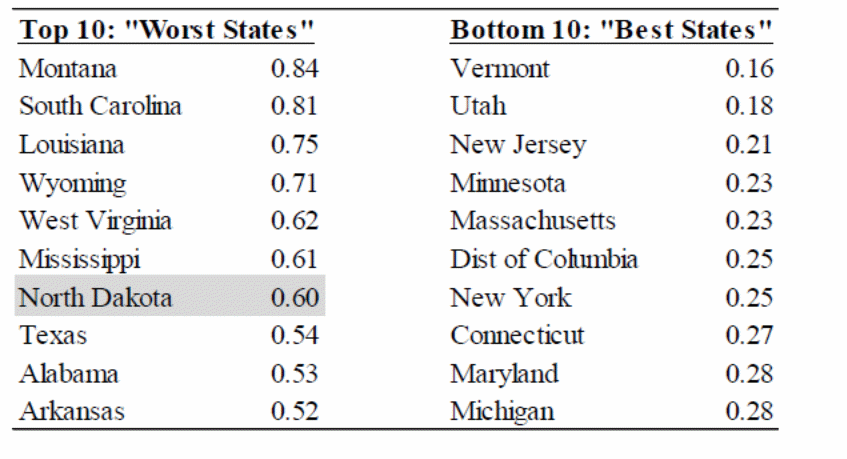
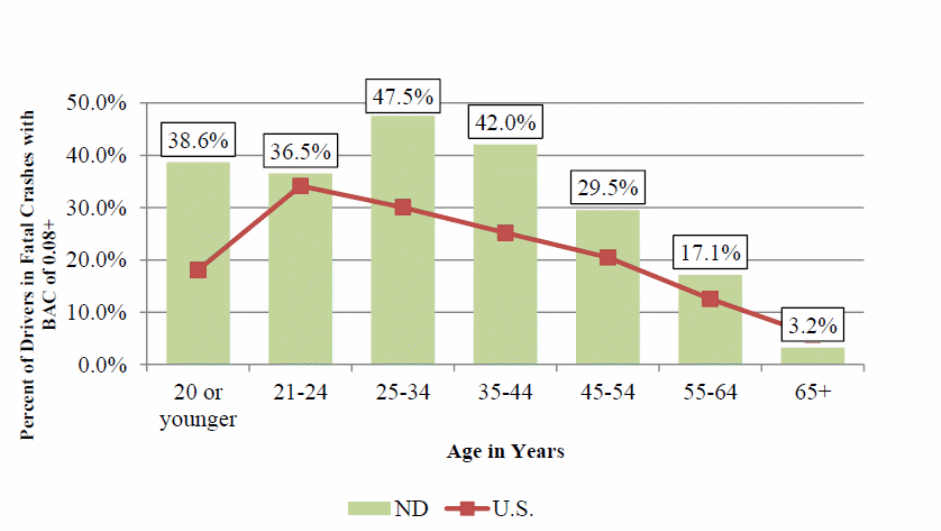
According to the study by SAMHSA (2010), self-reported driving under the influence of alcohol in the past year falls with increase in age. In other words, about 20% self-reported drunk-driving is found in the age group of 20 years or less, whereas it is just 3.2% in the age group of 65+. This also stresses the need to make stiffer laws to punish drunk driving by the underaged in the country (Huseth, 2012, p.8)
According to the report obtained from the respondents, breathalyzers are found to be useful by 63% in minimizing or stopping the impaired driving, trailed by 54% of the respondents who supported offering substitute transportation, vehicle confiscation and license suspension. About 48% of the respondents supported law enforcement initiatives, and 40% of the respondents observed that enhanced penalties for servers of alcohol to adolescents is appropriate. About 34% were of the opinion that there should be enhanced penalties for party hosts as an effective measures against underaged drinking habits (Boni et al, 2012, p.306).

One of the ways to stop or deter drunk driving is through the levy of fines, and a possible imprisonment. Michigan, North Carolina and North Dakota levies lowest maximum fines at $250 for the first time offenses of Driving Under the Influence, minor in vehicle and open container. Alaska, Alabama, Illinois, Delaware, Massachusetts, Iowa, Oregon, New Hampshire, Tennessee, South Dakota, Virginia, Texas, and Washington are the thirteen states having maximum fines of more than $ 1000 for the first time offenders. There will be an increase in fines if an adolescent is found in the vehicle, if there was high blood alcohol content, or there was an open alcohol container in the vehicle or if it was not the first time offense.
Levy of fines have been observed to have restricted drunk driving in this country. Many past empirical studies like Villaveces et al (2003), Wagenaar et al (2007) have found weak deterrent impact, while some studies have found no impact at al. According to Voas and Fisher (2009), the main reason why the fines have not yielded the desired results in some states is because the collection of such fines are so lenient of the offenders that they may fail to realize the weight of the offence.
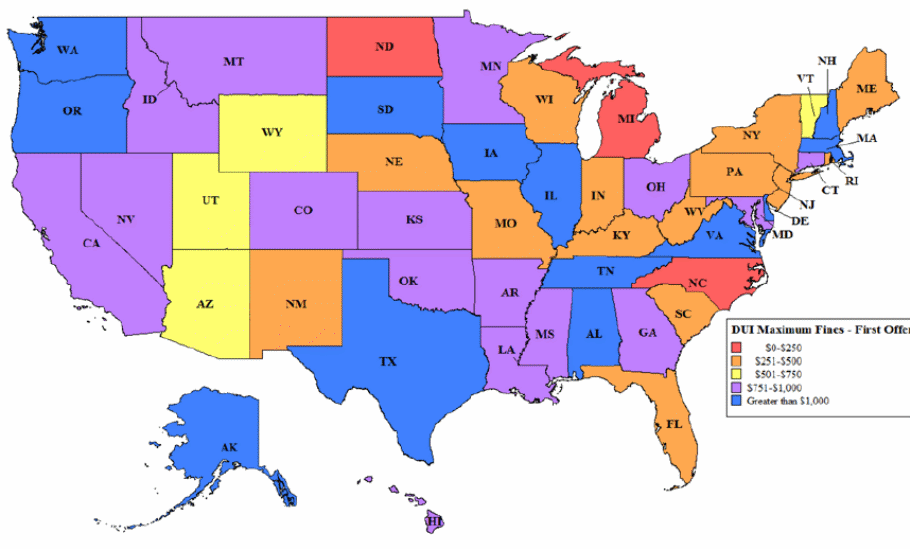
Results
According to the Report to Congress on the Prevention and Reduction of Underage Drinking study (2012), various data collected in this study points out that significant progress has been achieved in minimizing underage drinking practices in the United States. The above study demonstrates that there has been massive reduction in underage drinking in the United States mainly due to initiatives taken by the federal government, local governments, and active participation by non-governmental organizations, which have taken the underage drinking issue to a pinnacle place on the national public-health agenda. They have established a policy in to help regulate underage drinking. Laws has been enacted by both the local governments and state governments which enhanced understanding of the significance of protecting the underage from alcohol consumption. The above report stresses that despite the existing preventive measures, underage drinking rates in the US is still high, resulting in avoidable tragic safety and health outcomes among the adolescents of of this country. Their families, societies and communities as a whole have not been spared by these unfortunate outcomes. The above report stresses that there should be a continual, all-inclusive approach in stopping or minimizing underage drinking in the country (Report to Congress, 2012, p.17).
The report by Huseth (2012) notes that an evaluation of alcohol-impaired driving issues, including impaired fatality rates among states from 2003-2005, and 2006-2008 was made and it was found that alcohol related death rates has declined to 6.6% in Texas whereas Wyoming state witnessed abnormal of increase to 11.9%. Similarly, high-performance states witnessed a fall in alcohol related death rates to 40.4 in Mississippi and to 9.1% in South Dakota. Alcohol impaired driving is mostly influenced by the policy variations, driver demeanors, and cultural background. Huseth (2012) concludes that alcohol-impaired driving poses a serious threat for most of the states in the US even today. This means that prolonged evaluation of performance, and practices is required for ongoing performance enhancement in stopping drivers from drunk and driving (Huseth , 2012,p.42).
Morgan and Grube (1994) notes that apparent ease of accessing alcohol has increased frequency and extent of drinking among underaged in the country. The report by Monitoring the Future (MTF) survey (2002) observes that about ninety-five percentage of twelfth graders, eighty-five percent of tenth graders, and sixty-eight percent of eighth graders noted that it is “quite simple” or “very easy” to obtain alcohol. O’ Malley & Wagenaar (1991) study found that trials of alcohol availability are reasonably associated with alcohol consumption. Conventionally, prevention of alcohol usage among underaged individuals have focused on transforming drinking beliefs mainly through school-oriented education. According to Hecht, Graham & Elek (2006), some educational programs seem to be reasonably effective in minimizing adolescent drinking, or delaying drinking age. According to Gorman (1998), other studies have found school education programs to be less effective. Some hold that impacts of such programs are negligible, and found that long-term outcomes are ineffective (Komro & Toomey, 2002, p.7).
Cuijpers (2002) proposes peer-lead interactive delivery methods, and life skills prograns, social influence that insist on standards as a way of making the youth to promise not to drink while they are still under the age of 21 years, especialy before completing their college education.
According to Skara & Sussman (2003), some studies are conflicting, making conclusions complicated. Different scholars have given different views of how to deal with this issue (Dill & Wells-Parker, 2000, p.41). According to Mauss, Hopkins, Weisheit & Kearney (1998), school-based education cannot provide a complete answer to the problem as adolescents are submerged in a wider social framework in which alcohol is easily available and glamorized. It is true that school programs may be used to fight this vice, but success can only be achieved if the scope is broadened further. Some scholars believe that the adolescents can also be influenced to avoid alcohol through their faith. Interventions can be made through the media, normative education or indirectly by focusing on the environmental factors. The intervention should stive to attack factors that make alcohol available without any restriction. Strict implementation of Minor In Possession laws can help in this fight. More wide-ranging approaches that can support avoidance of alcohol should be implemented. The stkeholders should focus on resolving issues connected with underage drinking by transforming the larger society in which youth reside. Such efforts can be employed to minimize availability of alcohol to adolescents. All the stakeholders should join this fight and all the loopholes should be sealed. Stern actions should also be taken against the vendors who sell liquor to the adolescents.
Conclusions and Reccomendations
Conclusion
Underaged drinking has resulted in legal issues like arrests of the adolescents for driving while drunk or causing physical injuries to members of the public while drunk. There are also other issues caused by underage drinking such as hangovers or sickness. Underaged drinking may result into unwanted and unsafe sexual activities, sexual assaults, and higher incidences of homicide and suicide. Underaged drinking can also result into car- accidents, killing other innocent members of the public due to drunk driving. There are cases where underage drinking has resulted into unexpected death due to alcohol poisoning (CDC, 2012).
It is to be noted that in the year 2010, about 4,700 deaths occurred due to underage drinking. Although underage drinking is prohibited in the US, it is a known fact that about eleven percent of the total alcohol consumption is being taken by the adolescents (Goldberg, 2009, p.152). It is projected that seventeen percent of the aggregate expenses on alcohol are contributed by underage consumers in this country. The estimates state that it fetches about $23 billion dollars annually to the alcohol manufacturers (Stiles, 2011, p, 43). According to the study by Hingson et al. (2002), high incidences of underage drinking are connected with high risks of adverse lifetime alcohol-associated outcomes. The above statistical data indicate the necessity to find a viable solution to underage drinking as soon as possible.
In the United States, about half of the adolescent population has had a full drink of alcohol before reaching 15 years of age. National Survey on Drugs Use and Health (NSDUH) study conducted during 2005 shows that about five and a half percent of adolescents in the age of twelve and seventeen have been diagnosed with alcohol dependency and abuse (SAMHSA, 2005). After the enactment of several national laws prohibiting underage drinking, the rate of alcohol use and dependency amongst juveniles in the United States reduced significantly (Eigen & Noble, 2006). According to the Center for Disease Control and Prevention (CDC), underage drinking in the United States is should be fought in order to protect the future generation (Flower, 2012: Wagenaar & Wolfson, 2008).
According to the research by Miller et al (2005), underage drinking costs the American exchequer about $ 61.9 billion which included health care costs of about $5.4 billion, loss of productivity to the tune of $ 14.9 million, and loss of quality of life to the tune of $ 41.6 billion. It is to be noted that though these state laws bar the sale of alcohol to the underage people, they do not directly bar consumption of alcohol among this group. This is the main loophole in the present state laws on underage drinking, and the fight against access of alcohol to minors. The federal underage drinking law demands that a percentage of federal highway funds be withdrawn from any states that do not impose any ban on underage persons from buying being in possession of alcoholic drinks in public. By the year 1988, almost all the 50 states in the US had enacted their laws in line with the federal laws mainly to meet the funding requirements of federal governments, with some exemption which varied from state to state.
When minimum drinking age was reduced to 18 in the early 70s, there were high incidences of motor accidents caused by youths. A research study conducted by Wagennar and Toomey (2005) which analysed more than 241 empirical studies conducted on the subject found that if the minimum age is reduced to 18, then there would be increase in automobile accidents, and if the same is maintained at 21 year, the automobile accidents by youth reduced substantially. There is a need to enact an Act that would further protect the adolescents from possible harm due to excessive consumption of alcohol. States not adhering with such laws should not be allocated a part of their grants (Bonnie, 2004, p.170).
Some empirical studies have demonstrated that the existence of social host laws is linked with lesser drinking and driving-oriented causalities among young adults (Miller, 2013, p.910). Home delivery of alcohol is one area which goes unnoticed by the enforcement officials where adolescents may receive alcohol through this mechanism. To put a complete halt to the supply of alcohol to the underaged, the community should either restrict or ban the home delivery of alcohol (Miller, 2013, p. 910). One empirical study demonstrated that ban on sales of beer at football games at the University of Colorado , Boulder have minimized the rates of game day arrests, ejection from the stadium, assaults and referral of students to student affairs (Miller, 2013, p.910).
According to Whetten-Goldstein et al (2000) study, such positive measures should be suplemented by other measures to ensure that the adolescents are always protected.
Yagil (1998) notes that the overall tendency in alcohol-impaired driving can assist in identifying cases where improvement is required. It is also important in estimating the alcohol-associated automobile crashes (Huseth, 2012, p.3). As SAMHSA (2010) study observes, self-reported driving under the influence of alcohol in the past year fell with increase in age. This means that adults are less likely to be involved in drunk driving as compared to the adolescents (Huseth, 2012, p.8).
Recommendations
It is necessary to involve parents in this fight to make sure that rules about underage alcohol usage are adhered to even at home. The parents should know their role in this fight, and some of the consequences they may face for failing to observe the activities of their children. Nongovernmental organisations and institutions should work to foster a wide commitment to stop or minimise underage drinking through proper policies, acknowledging that adolescent alcohol usage is not a just a parental issue alone but a community issue that needs a joint initiative to resolve. The schools and colleges should frame and implement strict policies against alcohol usage on campus, and they should focus their attention on those strategies that are efficient in stopping or minimizing adolescent alcohol usage.
According to the study by Saffer (1991), nations with partial bar on alcohol advertising had a lesser alcohol consumption by underaged as compared to nations with partial ban. Saffer and Dhaval (2002) study which was carried out in 20 nations over twenty-six years revealed that a partial ban or a complete ban had reduced alcohol consumption by about 5 to 8%. Hence it is recommended that there should be a partial or complete ban on alcohol advertisement in the states to bring down alcohol consumption by teenage drinkers.
A study by MacKinnon, Pentz & Stacy (1993) found that US adolescents were easily attracted to the stickers on the alcohol bottles and the kind of message they were passing. This means that when the lebels are used to pass a warning to this group, there are chances that they can change their perception towards alcohol. In general, there is some evidence that warning labels on alcohol beverage have any visible impact young people taking alcohol. Government should involve more aggressive strategies by introducing new techniques so that warning label messages on the liquor containers reach the targeted adolescents drinkers to educate them about the evil of drinking.
Recent reports have shown that mass media counter-advertising strategies can help to reduce underaged drinking. According to Greenfield & Zimmerman (1993), the structure of media literacy initiatives to elevate public awareness of industry policies, and a module in school or community prevention may help to educate adolescent’s drinkers. There is a supporting evidence that cooperation are accomplished by introducing many-sided initiatives such as health messages at the point of public service announcements. Both federal and state governments should pay more attention to this strategy to reduce alcohol consumption among the adolescents.
Banning billboard of alcohol advertising will also help to reduce rate of alcohol consumption among the adolescents. As a preventive initiative to minimize alcohol promotion, billboard advertising, which can also include signs on buildings and freestanding signs, automobiles and other public places like subway advertisements or bus placards have been employed by communities. According to Hackbarth et al (2001), some communities have employed the initiative of limiting or minimizing the placement or number of billboards which have alcohol adverts. Such initiatives are based on the premise that constant exposure of the youth to alcohol advertisement could be one of the reasons why they indulge in its consumption at an early age. Both the federal and state governments should take more active steps to fight this negative publicity.
References
Abadinsky, H. (2008). Drug Use and Abuse: A Comprehensive Introduction New York:Cengage Learning.
American Psychological Association. (2001). Publication manual of the American Psychological Association (5th ed). Washington, DC: American Psychological Association.
Babor, T. (2010). Alcohol: No Ordinary Commodity: Research and Public Policy. Oxford: Oxford University Press.
Birckmayer JD, Boothroyd RI, Fisher DA, Gurbe JW & Holder HD (2008) Prevention of Underage Drinking: Logic Model Documentation. Calverton :PIRE.
Bonnie, RJ. (2004). Reducing the Underage Drinking: A Collective Responsibility New York: The National Academy Press
Boxbusiness.com (2012). States with the Most Underaged Drinking. Web.
CDC (2012). Facts Sheet. Underaged Drinking.
Criminal Defense Lawyer. (2012). Minor in Possession of Alcohol.
De Boni, R., Diemen, L. V., Duarte, P. D. C. A. V., Bumaguin, D. B., Hilgert, J. B., Bozzetti, M. C., & Pechansky, F. (2012). Regional differences associated with drinking and driving in Brazil. Revista Brasileira de Psiquiatria, 34(3), 306-313.
Dill, P. L., & Wells-Parker, E. (2006). Court-mandated treatment for convicted drinking drivers. Alcohol Research and Health, 29(1), 41
Drinking Age Procon. (2012).45 States that Allow Underage Alcohol Consumption.
Fell, J. C., Fisher, D. A., Voas, R. B., Blackman, K., & Tippetts, A. S. (2008). The relationship of underage drinking laws to reductions in drinking drivers in fatal crashes in the United States. Accident Analysis & Prevention, 40(4), 1430-1440.
Goldberg, R. (2009) Drugs Across the Spectrum (New York: Cengage Learning).
Gralton, C & Jones, I. (2010). Research Methods for Sport Studies. New York : Taylor & Francis.
Justice.uaa.alaska.edu (2010). Anchorage Underage Drinking Survey: Assessing Attitudes, Values. Retrieved from justice.uaa.alaska.edu ›… › 1010. Evaluation of VOA’s CMCA Strategies.
Kleiman, M A R & Hawdon, J E. (2011). Encyclopedia of Drug Policy, Vol.1, New York: Sage Publication.
Komro, K. A., & Toomey, T. L. (2002). Strategies to prevent underage drinking. Alcohol Research and Health, 26(1), 5-14.
Lovenheim, M. F., & Slemrod, J. (2010). The fatal toll of driving to drink: the effect of minimum legal drinking age evasion on traffic fatalities. Journal of Health Economics, 29(1), 62-77.
Miller, P M. (2013). Intervention for Addiction: Comprehensive Addictive Behaviors and Disorders, Volume 3, New York: Academic Press.
O’Malley, P. M., & Wagenaar, A. C. (1991). Effects of minimum drinking age laws on alcohol use, related behaviors and traffic crash involvement among American youth: 1976-1987. Journal of Studies on Alcohol and Drugs, 52(5), 478.
Rosner, R. (2012). Clinical Handbook of Adolescent Addiction. New York: John Wiley & Sons.
Rundio, A. (2012).Nursing and Addictions, An Issue of Nursing Clinics. New York:Elsevier Health Services.
Rutledge PC, Park A & Sher KJ. (2008). 21st Birthday Drinking. Extensively Extreme, Journal of Consulting and Clinical Psychology, 78,511-518.
Sadock BJ & Sadock VA. (2008). Kaplan & Sadock’s Concise Textbook of Clinical Psychiatry. New York: Lippincott Williams & Wilkins.
Samhsa.gov. (2008). Consequences and Risks of Underage Drinking. Web.
Shrewsbury Community Alliance. (2012).Underage Drinking Laws. Web.
Stiles, M. (2011). Mentoring Youth in Action. Bloomington:IUniverse
US legal. (2013). Underage Drinking Law & Legal Definition.
Wagenaar, A.C.; and Toomey, T.L. Effects of minimum drinking age laws: Review and analyses of the literature from 1960 to 2000. [2002] Journal of Studies on Alcohol, (Suppl. 14):206–225.
Wagennar, A C & Toomey T L. (2005). Effects of Minimum Drinking Age Laws: Review and Analyses on the Literature from 1960 to 2000. Web.
Wanberg KV, Timken DS & Milkman HB. (2010). Driving with Care. New York: SAGE.
Wang, W. Y. (2008). The Narrative Paradigm as a Perspective for Improving Effective Evaluation of Advertising. New York: ProQuest.
Footnotes
- CDC’s Web-based Injury Statistics Query and Reporting System (WISQARS) is an interactive database system that provides customized reports of injury-related data.